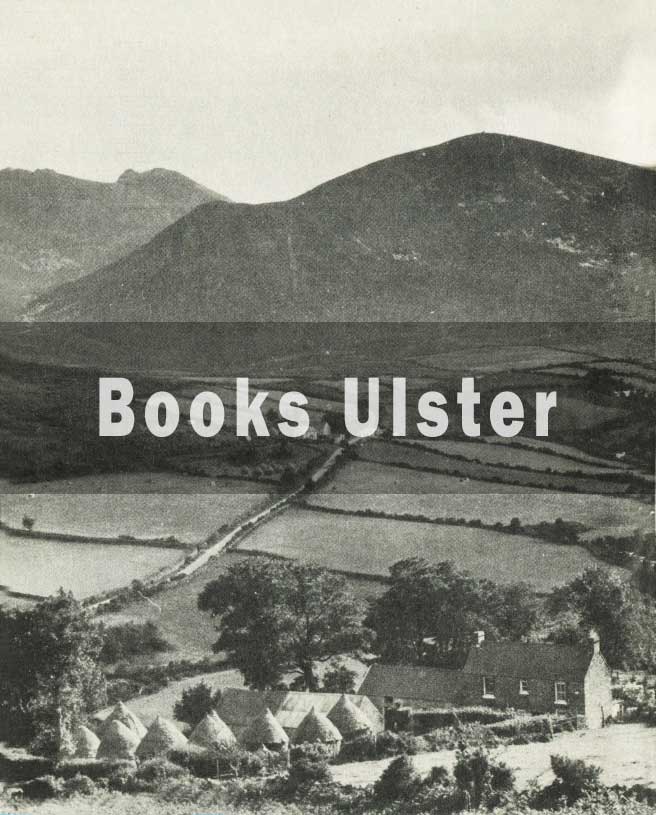Pocket Guide to Northern Ireland - The Country
| Source: | A Pocket Guide to Northern Ireland [.mobi (Kindle), .epub (iPad, etc.)] |
| Author: | War and Navy Departments, Washington, D.C. |
| Date: | 1943 |
NORTHERN Ireland—usually called Ulster—is a small country, only slightly larger than the State of Connecticut. It is made up of the six counties in the northeastern corner of the island: Antrim, Armagh, Down, Londonderry, Fermanagh, and Tyrone. Some 1,300,000 people—not quite so many as in Los Angeles—live there.
First off you may not like the Irish climate. It is damp, chilly, rainy. If you are from the Southwest or from California you may find yourself homesick for sunshine. The sun is only an occasional visitor in Ireland; there are about 200 rainy days a year. The rains, however, come usually as gentle drizzles, not as thundershowers.

A valley farm in County Down. Hay stacks are neatly thatched. Fields are bordered with hawthorn hedgerows or with rock fences like those in New England.
It may be news to you that Ireland is farther north than the United States. For this reason the day is very short in winter and long in summer. In late June and July there is little darkness and you will be able to read a newspaper at 9 o’clock at night. In late December daylight lasts less than 7 hours, and darkness closes in by midafternoon.
Despite Ireland’s northerliness—it lies about exactly opposite Labrador—extremes of heat and cold are rare. In the summer a temperature of 80 degrees is the peak of a heat wave, and in winter freezing weather is the exception rather than the rule. It is the always-present dampness which make the cool summers and mild winters seem colder than they are.
Many people in Ireland wear thick, woolen clothing the year round. You will be wise to keep yourself warm and dry; pneumonia and bronchitis are common.
Dampness chills the bones of visitors, but it makes Ireland green and beautiful. Ulster is a saucer circled by rolling hills. There is the Antrim plateau in the northeast, the Sperrin Mountains in the northwest, the Mourne Mountains in the southeast. If you come from North Carolina, or Colorado, or Idaho, these may not seem much like mountains to you—they rise 3,000 feet at their highest—but their beauty has drawn tourists to Ulster for many years.
On furlough you may want to visit the mountains, or to see Lough Neagh, the largest lake in the British Isles. (Lough, pronounced “Lokh,” is the Irish word for lake.) Another strange and famous landmark is the Giant’s Causeway—40,000 columns of basalt rock which rise from a bay at the northern tip of the island. This is celebrated in legend and story.
Most of Ulster’s 1,300,000 people live northeast of Lough Neagh, in the lowlands. There are a good many large estates owned by the wealthy or the once-wealthy, and you will find ancient and turreted castles scattered among the hills and glens, but most of the Irish farmers manage to make their livings on plots of land which Americans, used to tractors and far horizons, would think hardly larger than ample vegetable gardens.
This scale of farming will seem almost absurdly small to you who come from the Middle West or the Far West. There are 90,000 farms in Ulster with tiny fields and small, whitewashed, thatched-roof cottages. A 5-acre place is one of respectable size to an Ulsterman, a 20-acre place is really substantial, and anyone who owns more than 40 acres is considered to be engaged in large-scale farming. Fine cattle graze on the pasture land, and hay, oats, potatoes, turnips, and wheat are grown.
Belfast is the most important industrial center in Ireland, and one of the key points of the British war effort. It has a population of 438,000—one-third of the people in all Ulster live there—and is slightly larger than Kansas City, Missouri. Belfast was badly bombed by the Germans in 1940.[1] Londonderry (called Derry by the Irish), the second city of Ulster, is located on the North Coast, and had a population of 43,000 before the war.
Belfast today resembles many American cities where the weapons of war are being forged as fast as industrial wheels will turn. The production of linen in peacetimes is a great industry; Irish linens are known all over the world. Today much of the linen industry has been converted to the manufacture of cotton goods—cloth for British Army uniforms.
| Contents: | Contents |
| Previous: | There are Two Irelands |
| Next: | Government |
Yanks: British Views on America during the Second World War
This book comprises a selection of articles from the (British) Army Bureau of Current Affairs' WAR and CURRENT AFFAIRS pamphlets, all relating to America and, more particularly, to the relationship between the British and Americans during the Second World War.
"Our enemies are trying to make trouble between the British and the Americans during the war; they are certain to try it after they have been defeated, in the hope of escaping once more from the consequences of their crimes against humanity. It is our business to understand and work with the United States now and in peace-time; that means for us all at least to like and understand the Americans we meet."
ISBN: 978-1910375518

